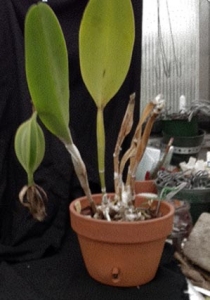Orchid Questions Answered
The recent article, Orchids, published at Fairfax Gardening not only stirred reader interest about growing orchids at home, it spurred several questions.
Joe Francis, the Fairfax Master Gardener and award-winning orchid grower who authored that article, answers some of those questions here.
Q. What is the purpose of planting in a transparent pot?
A. The big advantage in using a clear container is that you can see the moisture level in the plant’s growing medium, making it easier to know when to water. With a transparent pot, you can also monitor the condition of the roots’ important velamen covering.
Some orchid plants have exposed root systems that are essential to the photosynthesis process. Cattleya aclandia, for example, whose formative years over many millennia were spent on the top covering in the rainforest, developed this trait of root-surface dependency in order to bloom. This trait carries forward in its hybrid offspring to a lesser, but important, extent.
Q. What is the best way to water orchid plants?
A. First, determine whether the plant actually needs watering. By probing into the growing medium with your finger, you can determine how moist – or dry – the growing bark is. If you have a clear, plastic pot, you can observe the moisture level in the medium; or you can determine this by weighing the plant just after it is fully watered and by checking its weight seven days later.
Watering needs change with the seasons: Cold, dark, winter days call for longer intervals for watering. Hot, summer days necessitate two- or three-day intervals. It is best to water the plant at the point where it emerges from the medium, taking care to cover the full circumference of the container. Once a month, “flush” the plant with running water to remove accumulated salts from the water and fertilizer treatments.
There are many exceptions to these basic rules. Orchid plants mounted on cork slabs require at least daily watering in the hot summer period and perhaps on alternate days during cold and cloudy winter days.
The air roots emanating from the plant absorb the humidity in your growing area through their white velamen covering. It is especially important to create microclimates around your orchids with close spacing and humidity trays, with the plants perched on top of standing water, NOT into the water itself.
Q. What about the ice cube technique that comes with some plant instructions?
A. For the most part, orchids are found in tropical climates far from any ice environment. It is, therefore, counterintuitive to introduce an ice event. However, there is a reason for this recommendation that begins at the point of manufacture. The young orchid seedlings are placed into a moist, sphagnum moss growing base and lined up in unending rows in their nursery. This moss is slow to give up its moisture content; thus, the labor-intensive need to water is stretched out. Plants are shipped to their point of sale in this birthing cocoon. Adding the ice cubes weekly can maintain the moisture content in the root system without overwatering and breaking the drying cycle needed for the velamen surfaces on the roots. However, it would be much better for the plant if you took the three ice cubes and placed them in a vessel next to the plant. When the ice melts and attains room temperature, use that water to refresh the plant.
Q. How does one propagate orchids?
A. The quickest way to propagate orchids is by plant division. This applies to cattleya, dendrobrium, and epidendrum orchids that are commonly grown in homes. The most important step in this process, if you want to be highly successful, is to monitor for new root growth on the underside of the leading rhizome. You will likely have to remove the plant from its potting medium to inspect the rhizomes. If the plant has naturally divided, there will be two leading and independent growths. Each pseudo bulb (thickened areas that store nutrients for the plant) along the rhizome has two eyes (growth points). In most cases, only one of these eyes will become the new leading growth. The second eye remains dormant, awaiting a natural call to sprout should the first eye’s growth be severed or aborted. When root growth is present, count back three pseudo bulbs behind the lead growth. Using a sterile tool, sever the growth from the mother plant. It is important that you firmly anchor the transplant in its growing medium. Wobbly connections discourage new root growth.

Cattleya orchid with seed pod
Nature’s method of propagation is through the pollination process, developed in many cases with insect specific pollinators. Once the inserted pollen takes hold, the seed pod develops within the flower stem, and this pod will remain attached to the plant for anywhere between three and 13 months. Hybridizers might interrupt this gestation period midway and introduce the green seed directly onto the petri dish to test the efficacy of their hybrid effort. In nature, the seed pod eventually matures and splits open, relying on the natural wind movement to carry the seed aloft. A typical orchid seed pod may have 10,000 extremely fine seeds. If you find orchids in nature, you will see them growing in colonies, a testament to the seed aerodynamics and their wind carrier. The long duration to maturity begins when the lodged seed takes root.